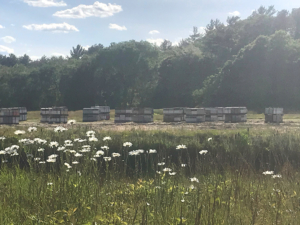Blossom Season
 While many think of cranberries as a fall fruit requiring much care and attention during the cooler months, the real work begins long before the autumn air arrives. The late spring and early summer months are vital to the cranberry crop’s success.
While many think of cranberries as a fall fruit requiring much care and attention during the cooler months, the real work begins long before the autumn air arrives. The late spring and early summer months are vital to the cranberry crop’s success.
During this time of year, the tender vines are developing cranberry buds that will turn into tiny, yet powerful, cranberry blossoms. As the bud and blossom develop, it is crucial to protect them from frost damage, provide adequate nutrients, and establish a healthy environment for growth. This phase of care and protection leads to the next critical element of crop success: pollination.
Typically, blossom time extends from mid-June through mid-July. As the tiny bud begins to open, its outer pink petals reveal a white flower. This is a unique time of year when the thousands of tiny white flowers cover the bog’s surface, resembling a light dusting of winter snow.
The sheer volume of flowers that require pollination vastly outweighs the number of native pollinators in a given bog area. For this reason, the A.D. Makepeace Company obtains a large quantity of honeybee hives and bumble bee boxes each spring to assist in the pollination process. The rule of thumb is approximately two honeybee hives per acre of cranberries or one bumble bee box per acre. While the two varieties of bees cannot be in close proximity to each other, each has its own strengths and characteristics. Although the cranberry industry has long debated the most beneficial bee, today the honeybee remains the primary bee of choice throughout the industry.
Hoppy Bog, Carver, Massachusetts
June 10, 2020
